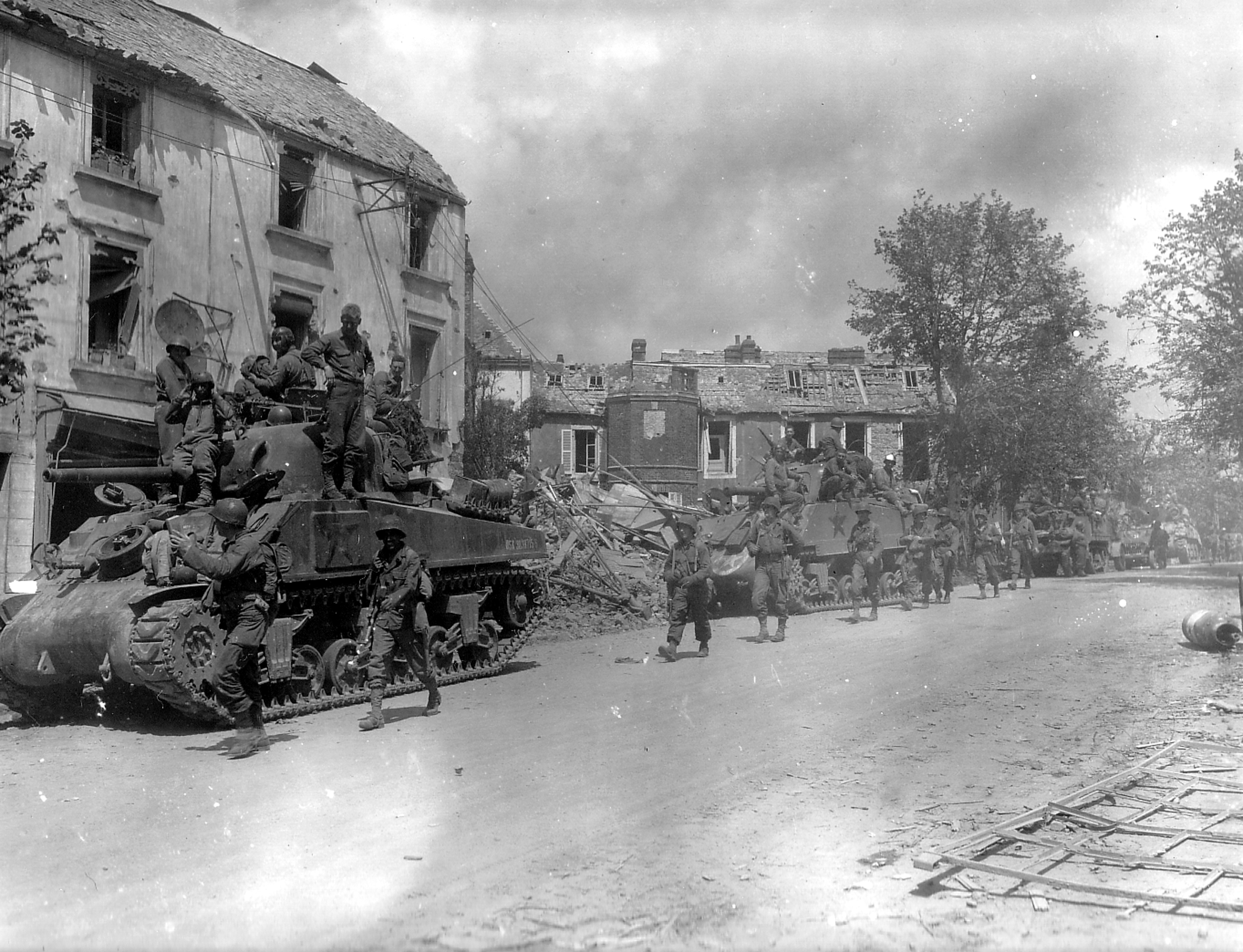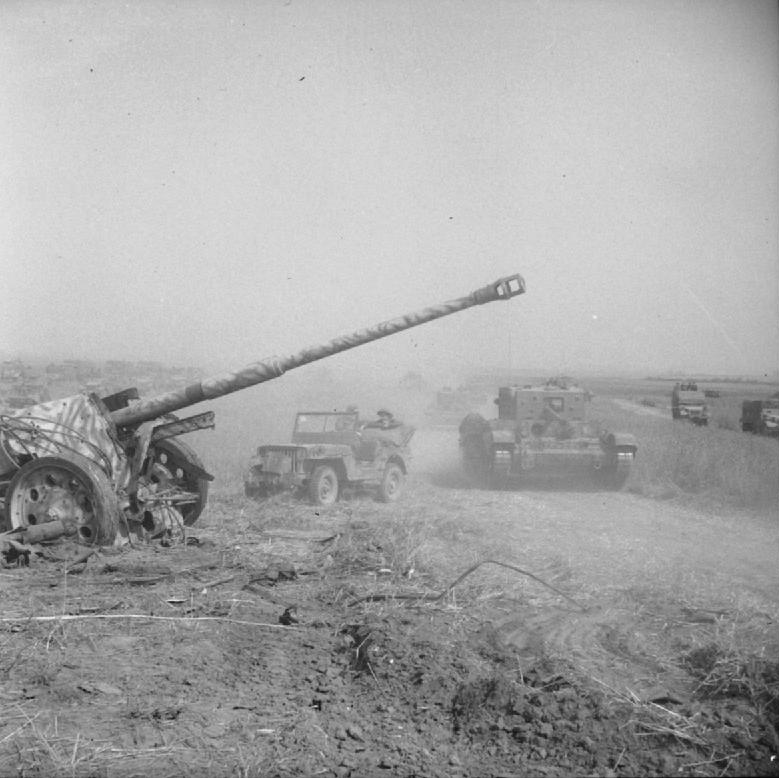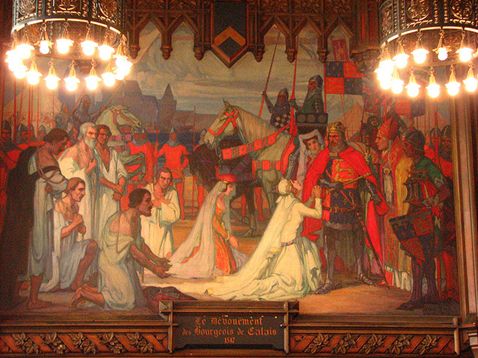|
Clearing The Channel Coast
Clearing the Channel Coast was a World War II task undertaken by the First Canadian Army in August 1944, following the Allied Operation Overlord and the victory, break-out and pursuit from Normandy. The Canadian army advanced from Normandy to the Scheldt river in Belgium. En route, they were to capture the Channel ports needed to supply the Allied armies, clear the Germans from the Channel littoral and launch sites for the V-1 flying bombs. The German 15th Army was able only to oppose the advance with sporadic resistance, wary of being outflanked and isolated by the rapidly advancing British Second Army on the right of the Canadians and executed an orderly retreat north-eastwards towards the Scheldt. On 4 September Adolf Hitler declared the Channel ports to be fortresses but Dieppe and Ostend were taken without opposition. Le Havre, Boulogne and Calais were subjected to set-piece assaults, after massed bombing and an attack on Dunkirk was cancelled and the garrison contain ... [...More Info...] [...Related Items...] OR: [Wikipedia] [Google] [Baidu] |
Siegfried Line Campaign
The Siegfried Line campaign was a phase in the Western European campaign of World War II, which involved engagments near the German defensive Siegfried Line. This campaign spanned from the end of Operation Overlord and the push across northern France, which ended on 15 September 1944, and concluded with the opening of the German Ardennes counteroffensive, better known as the Battle of the Bulge. Background German forces had been routed during the Allied break-out from Normandy. The Allies advanced rapidly against an enemy that put up little resistance. But after the liberation of Paris in late August 1944, the Allies paused to re-group and organise before continuing their advance from Paris to the River Rhine. The pause allowed the Germans to solidify their lines—something they had been unable to do west of Paris. By the middle of September 1944, the three Western Allied army groups; the Anglo-Canadian 21st Army Group (Field Marshal Sir Bernard Montgomery) in the nort ... [...More Info...] [...Related Items...] OR: [Wikipedia] [Google] [Baidu] |
German World War II Strongholds
German fortresses ( or , ; called pockets by the Allies) during World War II were bridgeheads, cities, islands and towns designated by Adolf Hitler as areas that were to be fortified and stocked with food and ammunition in order to hold out against Allied offensives. The fortress doctrine evolved towards the end of World War II, when the German leadership had not yet accepted defeat, but had begun to realize that drastic measures were required to forestall inevitable offensives on the ''Reich''. The first such stronghold was Stalingrad. Fortresses Eastern Front fortresses On the Eastern Front, Warsaw, Budapest, Kolberg, Königsberg, Küstrin, Danzig and Breslau were some of the large cities selected as strongholds. Western Front fortresses On the Western Front, Hitler declared eleven major ports as fortresses on 19 January 1944: IJmuiden, the Hook of Holland, Dunkirk, Boulogne-sur-Mer, Le Havre, Cherbourg, Saint-Malo, Brest, Lorient, Saint-Nazaire and the Gironde estua ... [...More Info...] [...Related Items...] OR: [Wikipedia] [Google] [Baidu] |
River Dives
The Dives (; also ''Dive'') is a 105 km long river in the Pays d'Auge, Normandy, France. It flows into the English Channel in Cabourg. The source of the Dives is near Exmes, in the Orne department. The Dives flows generally north through the following departments and towns: *Orne: Trun * Calvados: Morteaux-Coulibœuf, Saint-Pierre-sur-Dives, Troarn, Dives-sur-Mer, Cabourg The Dives is officially navigable up to the bridge at Putot-en-Auge although height restrictions apply. No yachts or fishing boats navigate the Dives further than the Pont de la Dives linking Dives-sur-Mer to Cabourg, 1 km from the river's estuary on the English Channel. The last kilometre of the Dives is a large meander encircling a man-made harbour and the holiday resort of Port Guillaume (William's harbour). The river is prevented from reaching the English Channel by a kilometre long sand dune called ''Le cap Cabourg''. The estuary of the Dives was the site of one of William the Conque ... [...More Info...] [...Related Items...] OR: [Wikipedia] [Google] [Baidu] |
I Corps (United Kingdom)
I Corps ("First Corps") was an army corps in existence as an active formation in the British Army for most of the 80 years from its creation in the World War I, First World War until the end of the Cold War, longer than any other corps. It had a short-lived precursor during the Waterloo Campaign. It served as the operational component of the British Army of the Rhine (part of NATO's Northern Army Group (NORTHAG)) during the Cold War, and was tasked with defending West Germany. Napoleonic precursor Assembling an army in Belgium to fight Napoleon's resurgent forces in the spring of 1815, the Arthur Wellesley, 1st Duke of Wellington, Duke of Wellington formed it into army corps, deliberately mixing units from the Anglo-Hanoverian, Dutch-Belgian and German contingents so that the weaker elements would be stiffened by more experienced or reliable troops. As he put it: 'It was necessary to organize these troops in brigades, divisions, and corps d’armee with those better disciplined ... [...More Info...] [...Related Items...] OR: [Wikipedia] [Google] [Baidu] |
Siegfried Line
The Siegfried Line, known in German as the ''Westwall (= western bulwark)'', was a German defensive line built during the late 1930s. Started in 1936, opposite the French Maginot Line, it stretched more than from Kleve on the border with the Netherlands, along the western border of Nazi Germany, to the town of Weil am Rhein on the border with Switzerland. The line featured more than 18,000 bunkers, tunnels and tank traps. From September 1944 to March 1945, the Siegfried Line was subjected to a large-scale Allied offensive. Name The official German name for the defensive line construction program before and during the Second World War changed several times during the late 1930s. It came to be known as the "Westwall", but in English it was referred to as the "Siegfried Line" or, sometimes, the "West Wall". Various German names reflected different areas of construction: * Border Watch programme (pioneering programme) for the most advanced positions (1938) * Limes programme ... [...More Info...] [...Related Items...] OR: [Wikipedia] [Google] [Baidu] |
Falaise Pocket
The Falaise pocket or battle of the Falaise pocket (; 12–21 August 1944) was the decisive engagement of the Battle of Normandy in the Second World War. Allied forces formed a pocket around Falaise, Calvados, in which German Army Group B, consisting of the 7th Army and the Fifth Panzer Army (formerly ), were encircled by the Western Allies. The battle resulted in the destruction of most of Army Group B west of the Seine, which opened the way to Paris and the Franco-German border. Six weeks after the 6 June 1944 Allied invasion of Normandy, German forces were in turmoil, having expended irreplaceable resources defending the frontline and with Allied air superiority threatening the availability of food and ammunition. However, on the Allied side, British forces had expected to liberate Caen immediately after the invasion, an operation which ended up taking nearly two months, and US forces had expected to control Saint-Lô by the 7 June, yet German resistance delayed this u ... [...More Info...] [...Related Items...] OR: [Wikipedia] [Google] [Baidu] |
Antwerp
Antwerp (; ; ) is a City status in Belgium, city and a Municipalities of Belgium, municipality in the Flemish Region of Belgium. It is the capital and largest city of Antwerp Province, and the third-largest city in Belgium by area at , after Tournai and Couvin. With a population of 565,039, it is the List of most populous municipalities in Belgium, most populous municipality in Belgium, and with a metropolitan population of over 1.2 million people, the country's Metropolitan areas in Belgium, second-largest metropolitan area after Brussels. Definitions of metropolitan areas in Belgium. Flowing through Antwerp is the river Scheldt. Antwerp is linked to the North Sea by the river's Western Scheldt, Westerschelde estuary. It is about north of Brussels, and about south of the Netherlands, Dutch border. The Port of Antwerp is one of the biggest in the world, ranking second in Europe after Rotterdam and List of world's busiest container ports, within the top 20 globally. The city ... [...More Info...] [...Related Items...] OR: [Wikipedia] [Google] [Baidu] |
Breskens Pocket
The Breskens Pocket was a pocket of fortified German resistance against the Canadian First Army in the Battle of the Scheldt during the Second World War. It was chiefly situated on the southern shore of the Scheldt estuary in the southern Netherlands, near the Belgian border. It was named after the town of Breskens, which was later freed from German occupation during Operation ''Switchback''. Order Of Battle Allied Forces Canadian First Army * 3rd Canadian Division * 4th Canadian Division Axis Forces 15th Army (Wehrmacht) * 64th Infantry Division Aftermath An intelligence summary by 1st Canadian Army in the immediate wake of the battle, referred to the 64th Infantry Division as "the best infantry division we have met." The Germans had been well supported by numerous heavy guns of the Atlantic Wall and the terrain had been atrocious. Canadian official history noted, Belgian military manuals described the local polder as "generalement impropre aux operations militaires". T ... [...More Info...] [...Related Items...] OR: [Wikipedia] [Google] [Baidu] |
Battle Of The Scheldt
The Battle of the Scheldt in World War II was a series of military operations to open up the Scheldt river between Antwerp and the North Sea for shipping, so that Antwerp's port could be used to supply the Allies in north-west Europe. The operations were carried out by the First Canadian Army, with assistance from Polish and British units which had been attached. The action was under the acting command of the First Canadian's Lieutenant-General Guy Simonds. The battle took place in the vicinity of the Scheldt river in northern Belgium and southwestern Netherlands from 2 October to 8 November 1944. The Canadians had been delayed, and the need to clear the Scheldt had not yet been addressed, due to Allied decisions up to that point to focus instead on Arnhem ( Operation Market Garden), Boulogne ( Operation Wellhit), Calais ( Operation Undergo) and Dunkirk. By the time the Canadians were sent into the Battle of the Scheldt, the Wehrmacht defenders had been reinforced. The Germa ... [...More Info...] [...Related Items...] OR: [Wikipedia] [Google] [Baidu] |
Dunkirk
Dunkirk ( ; ; ; Picard language, Picard: ''Dunkèke''; ; or ) is a major port city in the Departments of France, department of Nord (French department), Nord in northern France. It lies from the Belgium, Belgian border. It has the third-largest French harbour. The population of the commune in 2019 was 86,279. Etymology and language use The name of Dunkirk derives from West Flemish 'dune' or 'dun (fortification), dun' and 'church', thus 'church in the dunes'. A smaller town 25 km (15 miles) farther up the Flemish coast originally shared the same name, but was later renamed Oostduinkerke(n) in order to avoid confusion. Until the middle of the 20th century, French Flemish (the local variety of Dutch language, Dutch) was commonly spoken. History Middle Ages A fishing village arose late in the tenth century, in the originally flooded coastal area of the English Channel south of the Western Scheldt, when the area was held by the County of Flanders, Counts of Flanders, va ... [...More Info...] [...Related Items...] OR: [Wikipedia] [Google] [Baidu] |
Calais
Calais ( , , traditionally , ) is a French port city in the Pas-de-Calais department, of which it is a subprefecture. Calais is the largest city in Pas-de-Calais. The population of the city proper is 67,544; that of the urban area is 144,625 (2020). and it is reflected in the city's name in the local Picard language, ''Calés''. Other archaic names for the city are Portuguese ''Calêsio'' and German ''Kalen''. ''Kales'', the city's historic name in Dutch and West Flemish (once spoken in the area) was retained until more recently in the name for the Strait of Dover, ''Nauw van Kales'', and is still used in Dutch sources wishing to emphasise former linguistic ties to the area. Though the modern French spelling of ''Calais'' gradually supplanted other variants in English, the pronunciation () persisted and survives in other towns named for the European city including Calais, Maine, and Calais, Vermont, in the United States. In " De Gustibus" (1855), Robert Browning r ... [...More Info...] [...Related Items...] OR: [Wikipedia] [Google] [Baidu] |
Boulogne
Boulogne-sur-Mer (; ; ; or ''Bononia''), often called just Boulogne (, ), is a coastal city in Hauts-de-France, Northern France. It is a Subprefectures in France, sub-prefecture of the Departments of France, department of Pas-de-Calais. Boulogne lies on the Côte d'Opale, a touristic stretch of French coast on the English Channel between Calais and Normandy, and the most visited location in the region after the Lille conurbation. Boulogne is its department's second-largest city after Calais, and the 183rd-largest in France.Téléchargement du fichier d'ensemble des populations légales en 2017 Institut national de la statistique et des études économiques, INSEE It is also the country's largest fishing port, specialising in herring. Boulogne is an ancie ... [...More Info...] [...Related Items...] OR: [Wikipedia] [Google] [Baidu] |








